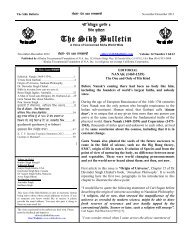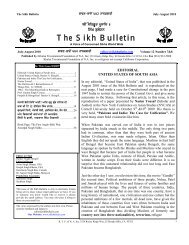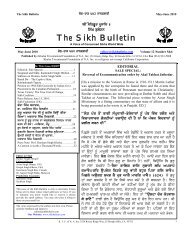hirmMdr ik drbwr swihb - The Sikh Bulletin
hirmMdr ik drbwr swihb - The Sikh Bulletin
hirmMdr ik drbwr swihb - The Sikh Bulletin
You also want an ePaper? Increase the reach of your titles
YUMPU automatically turns print PDFs into web optimized ePapers that Google loves.
<strong>The</strong> S<strong>ik</strong>h <strong>Bulletin</strong> mwG-Pgx 542 nwnkSwhI January-February 2011<br />
Kay, Vasia Soey. He created (kar kay) the creation<br />
(kudrat) and resides (vasia) within it. On page 998 of<br />
the GGS, Guru Arjun similarly writes: Sabh Meh Ek<br />
Niranjan Karta, Sabh Kar Kar Vekhey Apey Chalta.<br />
<strong>The</strong> one detached Creator creates all and attaches<br />
Himself within all. He oversees all his Creation and its<br />
running. In S<strong>ik</strong>hism therefore, God is real. So is His<br />
creation. But the S<strong>ik</strong>h is to see God as the permanent<br />
reality and creation as a reality subject to the wishes<br />
and desires of the Creator. His creation will remain real<br />
as long as He wants to keep it that way. Yes, life is<br />
transient, unpredictable and temporary. But it is to be<br />
lived in a real way within a real world with the<br />
underlying emotion that we have to leave it behind<br />
someday. <strong>The</strong> difference between Hinduism and<br />
S<strong>ik</strong>hism on the notion of creation is thus<br />
fundamental and as immense as it can be between<br />
reality and illusion.<br />
It can be argued that the above two differences are<br />
intrinsic enough to create an entire plethora of<br />
divergence at the secondary levels. <strong>The</strong>re may thus be<br />
no real need to provide a “list” of differences per se.<br />
SECOND ISSUE: Within paragraph 8 of his letter,<br />
Sidhu writes: “Guru Nanak did not condemn (the)<br />
janeu, but the falsehood behind it. He actually pleaded<br />
to get a janeu of a certain kind, which he will (sic)<br />
gladly wear. May I know, what is the difference<br />
between a janeu and a gatra or panj kakaars?”<br />
Guru Nanak’s views on the janeu are contained in<br />
numerous places within the GGS (page 351, 355, 471,<br />
903, and 951 for instance). <strong>The</strong>re is a difference<br />
between rejecting the janeu and pointing out the<br />
falsehood behind it. Guru Nanak’s writings in the GGS<br />
indicate that he critiqued both the falsehood and the<br />
truths that were evident of the janeu. This is a crucial<br />
point that Sidhu misses. <strong>The</strong> primary truths of the janeu<br />
were two. First, it was meant to denote the class of the<br />
wearer – different classes wore it differently and it was<br />
made of different material for different castes. <strong>The</strong><br />
second truth was that the janeu was denied to the<br />
female. So when the janeu ritual was performed on<br />
young Nanak, he asked the pandit to explain to him<br />
why his elder sister Nanaki was not given one to wear.<br />
<strong>The</strong> pandit narrated the truth as it stood then – Nanaki<br />
would have been entitled to one had she been born<br />
male. Guru Nanak responded that if something was<br />
denied to one half of mankind, he would not be part of<br />
it. He thus refused to adorn it. Here then – at the most<br />
simplistic level - lies the first difference between the<br />
janeu and gatra. One is gender specific, the other<br />
gender neutral. <strong>The</strong> implications are severe in that<br />
one can be considered a symbol of discrimination<br />
while the other one of equality. Nowhere is there a<br />
prohibition against the female with regards the<br />
gatra kirpan. <strong>The</strong>n the Guru proceeded to enquire<br />
about the material that was used to make the janeu.<br />
<strong>The</strong> line of questioning depicts the depth of Guru<br />
Nanak’s concerns with both the truths and falsehoods<br />
of the janeu. <strong>The</strong> pundits answer was also two fold –<br />
he described the quality of the cotton and the process<br />
of its construction and tied it to Guru Nanak’s<br />
perceived class (Khatri). Thus far the pandit was<br />
speaking about the truths of the janeu. Herein then,<br />
lies the second difference. <strong>The</strong> gatra has no such<br />
class or creed distinctions, and the kakars are<br />
meant to unify its wearers. In order to convince<br />
Guru Nanak to adorn the janeu, the pandit went on to<br />
narrate the spiritual aspect of the jeneu – in particular<br />
the fact that in the afterworld, the janeu would provide<br />
recognition for one’s spirituality. Here, as far as Guru<br />
Nanak was concerned, the pandit was stepping into the<br />
arena of spiritual falsehoods. How could a piece of<br />
cotton, spun, woven and tied into specific number of<br />
knots have even an iota of spiritual essence? Hence<br />
his famed critique on page 441 of the GGS: Dya<br />
Kapah Santokh Soot, Jat Ghandee Sat Vat. Cotton (the<br />
basic ingredient of the janeu) is my compassion,<br />
contentment my thread, modesty the knot and truth the<br />
twist. This is the sacred thread of the soul; if you have<br />
it, then spin one. Only such a janeu will not break, get<br />
soiled, be burnt, or lost. Blessed are those mortal<br />
beings, O Nanak, who wear such an adornment around<br />
their necks. <strong>The</strong> thread is bought for a few shells. It is<br />
weaved and put on while seated in a “holy” enclosure<br />
by the brahmin who acts as a guru in convincing the<br />
wearer to adorn it. But in death, even the brahmin’s<br />
sacred thread falls away, and his soul departs without<br />
it.”<br />
So Sidhu’s assertion that Guru Nanak merely<br />
condemned the “falsehood behind the janeu and<br />
pleaded to get a janeu of a certain kind, which he will<br />
(sic) gladly wear” is superficial. In essence what<br />
Guru Nanak did was to (i) reject the truths of the janeu<br />
(ii) critique the falsehoods that sustained the janeu (iii)<br />
create a set of original truths for the janeu<br />
(compassion, contentment, modesty and truth) and (iv)<br />
benchmark the role and position of symbols (in this<br />
K. T. F. of N. A. Inc. 3524 Rocky Ridge Way, El Dorado Hills, CA. 95762 8

















